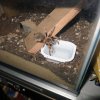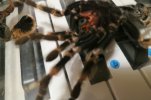- Messages
- 21
- Location
- Lancashire area
Unsure of its age but it isn’t a adult. Probably one more molt and then a sub adult so it is very smaller. Maybe around 4 inch leg span. I’ve been trying to feed her every other day or so but she will not feed and actually avoids the cricket. I’m unsure why. The crickets are perfect for her size. She hasn’t fed for nearly 3 weeks and there are no signs of pre molt. The temperature and humidity are pretty much perfect condition. Any advice would be great
See photo below for a size comparison to a 50p and milk bottle cap (which is her water dish.
See photo below for a size comparison to a 50p and milk bottle cap (which is her water dish.








